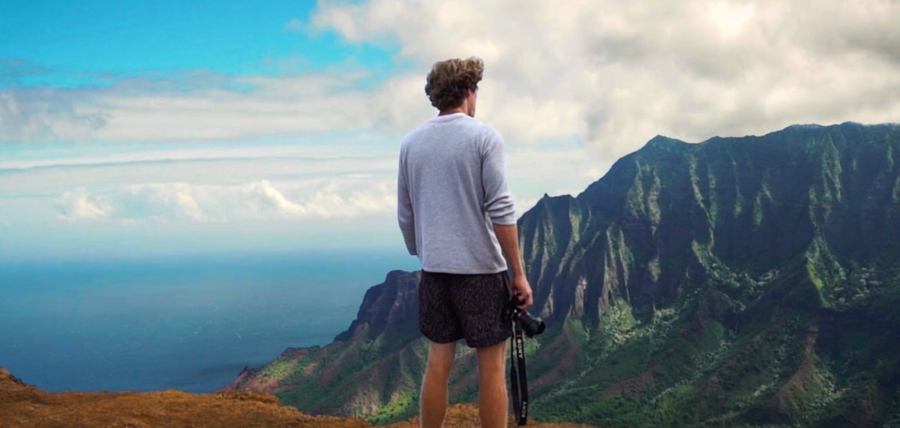The digital realm, once merely a transmission channel, has evolved into a vast canvas where new forms of artistic expression unfold. Amidst this transformation, Ryan Shirley emerges as a central figure whose work reaches its audience not through conventional gallery or museum systems, but through the expansive, democratic space of online platforms. His work, primarily in the field of travel cinematography, goes beyond mere tourism promotion, offering a distinctive aesthetic experience.
The evolution of Ryan Shirley’s creative career, which led from initial “magic and science videos” to his current specialization in travel cinematography, reveals a fundamental artistic curiosity and remarkable adaptability. This development suggests that his medium is less static than his constant pursuit of captivating visual narratives. His early engagement with visual representations and explanations, often accompanied by special effects, served as a kind of laboratory for the development of his visual storytelling skills. The transition to travel cinematography utilized these acquired skills, composition, editing, and narrative flow, and transferred them to real landscapes and cultures. This underscores that his artistic impulse extends beyond a single genre, rooted in the act of visualizing and sharing. His “channel” is the digital screen, and his “subject” is the world itself, interpreted through his unique lens.
Context and Origins: The Digital Canvas and the Traveling Gaze
Ryan Shirley’s rise as a digital artist is closely linked to the emergence and expansion of the online ecosystem, particularly platforms like YouTube and Instagram. His journey did not begin in academic art institutions or established studios, but in a realm characterized by experimentation and direct audience interaction. His early works, focusing on “magic and science videos,” were a kind of creative playground where he refined his visual storytelling skills. This phase can be seen as a self-directed artistic development that took place outside traditional formal training, as is common, for example, for other personalities with similar names in the art world.
The fact that Ryan Shirley combined his passion for travel with his talent for videography and launched a YouTube channel showcasing his global expeditions led to massive audience success. This path is indicative of the democratization of art production and dissemination enabled by digital platforms. Unlike traditional art careers, which often rely on formal education or galleries, Shirley’s artistic development is organic and audience-driven. His early videos, likely experimental and self-taught, served as a melting pot for the development of the visual narrative skills he later applied to travel. This was comparable to an artist’s early sketches or studies, but publicly shared. His success challenges the access barriers of the traditional art world, suggesting that artistic value and cultural impact can now be validated through direct audience engagement on a global scale, rather than solely through the critical consensus of established institutions. This redefines the “context” for contemporary art. The “travel influencer” in this light becomes a modern incarnation of the landscape painter or ethnographic documentarian, but operating with new tools and through different distribution channels.
The Artistic Signature: Aesthetics of Movement and Experience
Ryan Shirley’s distinctive visual language shapes his travel cinematography, elevating it beyond mere documentation. His artistic signature manifests in careful compositional choices, a nuanced use of light, precise color grading, and a dynamic narrative pace. A central element of his style is his mastery of drone cinematography. Through the use of drones, he transforms familiar landscapes into abstract patterns or monumental panoramas that convey a sense of awe and immense scale. This is not just a technical skill, but an artistic decision that opens up new, often unexpected perspectives for the viewer.
The “cinematic visuals” and “high-quality production” of his content are crucial to their emotional resonance and their ability to transport the viewer. He doesn’t just create images of places; he crafts a comprehensive “experience.” The conscious decision for 8K resolution and consistently “high-quality production,” coupled with the use of drone cinematography, reveals a pursuit of hyperrealism and immersive visual fidelity. This is more than just technical finesse; it is an artistic strategy aimed at overwhelming the senses and creating a heightened sense of presence that blur the line between viewing and experiencing. The high resolution allows for unprecedented detail, drawing the viewer deeper into the landscape. Drone shots offer previously inaccessible perspectives, transforming familiar scenes into novel, almost abstract compositions. This combination creates an immersive experience where the viewer feels transported, almost physically present. This pursuit of immersive reality can be understood as a contemporary evolution of landscape painting or photography, where the artist attempts to capture not just the image, but the feeling of a place. The implicit narrative structures in his videos, the journey, the discovery, the immersion, contribute significantly to his unique “storytelling,” making his works more than just a sequence of shots.
Reception and Impact: The Resonance of Millions
Ryan Shirley’s influence can be quantified by his “millions of subscribers” and “millions of views,” representing a unique form of reception in the digital age that differs from traditional art criticism or gallery visits. The nature of this reception is multifaceted: his content not only entertains but also “inspires” by evoking wanderlust and establishing a connection to global landscapes and cultures. He has established himself as a “prominent travel influencer, YouTuber, and content creator” who has “captured the hearts of millions.”
Ryan Shirley’s “millions of subscribers” and diverse income streams demonstrate a shift in the validation of artistic success, moving away from institutional critique towards mass audience engagement and economic self-sufficiency. His reception is not measured by critical essays in academic journals, but by views, subscriptions, and commercial partnerships that directly link artistic output to market value and popularity. This demonstrates a fundamental redefinition of “artistic success” in the digital age. Traditionally, success in the visual arts is often validated by critical acclaim, museum acquisitions, or gallery sales, as is the case, for example, with philanthropist Shirley W. Ryan, who is associated with the Art Institute of Chicago and the Shirley Ryan AbilityLab. For Ryan Shirley, however, the value of his art is directly validated by its consumption by millions of people, whose engagement enables his continued creation. The ability to “turn his passion for travel into a thriving career” is a direct result of his capacity to create captivating visual content that resonates with a mass audience. This commercial success then flows back into his artistic practice, allowing him to “reinvest in his content, ensuring his videos maintain their high production value.” This model blurs the lines between artist, entrepreneur, and entertainer, proposing a commercially viable model for creative production that is directly accountable to its audience, fostering a new kind of “patronage” through views and engagement.
Discourse and Cultural Significance: The World as a Visual Narrative
Ryan Shirley’s work is embedded in a broader cultural discourse about globalization, environmental awareness, and the mediated experience of reality. His depiction of “most beautiful places” as well as “landscapes, cultures, and wildlife” raises the question of whether it contributes to a deeper understanding or merely enables a superficial consumption of global diversity. His “cinematic visuals” and “high-quality production” of “landscapes, cultures, and wildlife” contribute to a mediated, curated world experience. This triggers a critical discourse about the authenticity of digital travel and its impact on collective perception and desire, especially in contrast to real concerns such as overcrowding and environmental pollution.
His work, while visually stunning, contributes to a global “travel imaginarium” that is often disconnected from practical realities and environmental impacts. By presenting “beautiful places” in an idealized, cinematic way, he could inadvertently promote the very overtourism and environmental degradation that concern some travelers. This creates a tension: his art inspires exploration, yet the scale of this inspiration, enabled by digital reach, has real consequences. The “transformation” he achieves is not just that of landscapes into narratives, but potentially also that of pristine places into tourist commodities. This prompts a critical discourse on the ethical responsibility of digital artists and influencers who shape global perceptions. Does the aestheticization of travel serve education, or does it merely perpetuate a consumerist gaze? Shirley’s work becomes a lens through which the complex relationship between visual media, global tourism, and environmental awareness in the 21st century can be examined.
Innovation and Development: The Artist as a Dynamic Ecosystem
Ryan Shirley’s artistic practice is characterized by remarkable adaptability and continuous evolution. His journey from “magic and science videos” to specialized “travel cinematography” is a testament to his dynamic approach to visual creation. This evolution is not just a change of subject matter, but a constant refinement of his skills and techniques.
A key aspect of his innovative power is his commitment to “reinvesting in his content.” This means that a portion of his earnings directly flows into improving production quality, whether through the use of state-of-the-art technology like 8K cameras or the further perfection of his drone footage. This reinvestment creates a positive cycle in which commercial success directly drives artistic quality and innovation. Unlike traditional artists who might rely on grants or sales to patrons, as is the case with philanthropist Shirley W. Ryan and her contributions to research, Shirley’s audience is his patron. Their engagement, in the form of views and clicks on sponsored content, directly funds his next artistic projects. This direct feedback loop fosters continuous improvement and experimentation.
The diversification of his income streams, “YouTube ad revenue, sponsored content and brand deals, affiliate marketing, merchandise sales, photography and videography projects,” is not just a business model, but a strategic decision for creative independence and longevity in the digital space. These diverse income streams provide him with a buffer zone, allowing him to maintain artistic freedom rather than being dependent on a single source or the taste of a single patron. Ryan Shirley thus embodies a new archetype of the contemporary artist: a versatile creator, technologist, and entrepreneur who constantly reinvents himself in a rapidly changing media landscape. This model points to a future for artists where financial viability is closely linked to direct audience engagement and the strategic management of one’s creative output as a “brand.” It challenges the traditional separation of art and commerce, proposing a symbiotic relationship where commercial success can directly fuel artistic ambition and technical excellence.
Ryan Shirley’s cinematic art, born from the digital age, challenges and expands our understanding of what constitutes “art” and “artist” in the 21st century. His ability to “turn his love for adventure into a successful career” through digital cinematography represents a paradigm shift in artistic creation and consumption. His work, by evoking “admiration and inspiration,” not only entertains but also subtly educates and shapes a global awareness of distant lands. It effectively democratizes access to visual “art experiences.”
This “transformation” is not only personal but also cultural. His “art” transforms passive viewing into active inspiration. This suggests that the digital space has lowered the barrier to entry for both artists and audiences, making high-quality visual experiences accessible to millions who would never visit a traditional gallery. His work therefore functions as a powerful cultural force, shaping perceptions of the world and fostering a new form of global visual literacy. If the purpose of art is to move, provoke, inspire, and offer new perspectives on the human condition or the world around us, then Ryan Shirley’s digital canvases, viewed by millions, undoubtedly fulfill a significant artistic role in the 21st century. His legacy may not be found in museum collections, but in the collective memory and imagination of a globally connected audience.









